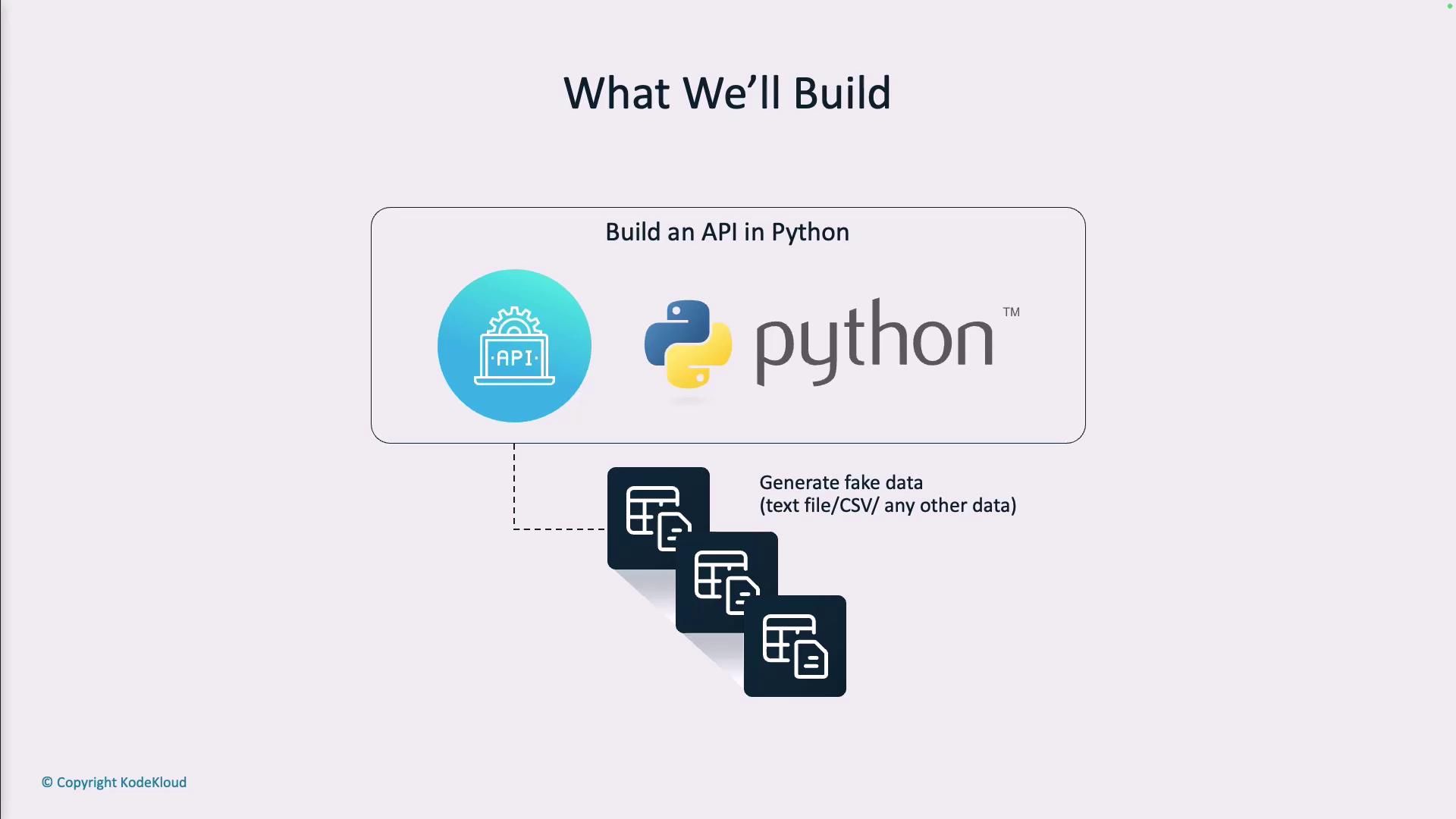GitHub Copilot Certification
Using Copilot Efficiently
Introduction
In this guide, you’ll learn how to build a Fake Data Generator API in Python using GitHub Copilot. By the end, you’ll have a service that produces mock customer records in JSON, CSV, or plain text—perfect for development and testing without exposing real personal data.
Table of Contents
- Module Overview
- Project Scenario
- Prerequisites
- Setup and Installation
- API Implementation
- In-Code Documentation
- Unit Testing with Pytest
- Generate API Documentation
- AI Pair Programming
- References
Module Overview
In this module, we will:
- Initialize a new Python project
- Implement the Fake Data Generator API using FastAPI
- Add comprehensive docstrings and inline comments
- Write unit tests with Pytest
- Auto-generate interactive API documentation
- Demonstrate AI pair programming with GitHub Copilot
Project Scenario
A new company policy prohibits using real customer data in test environments. To comply and maintain developer productivity, we’ll build an API service that generates synthetic customer records on demand.
Example JSON output:
[
{
"first_name": "Catherine",
"last_name": "Parker",
"email_address": "[email protected]",
"age": 27,
"city": "Austin",
"occupation": "Graphic Designer"
},
{
"first_name": "Ethan",
"last_name": "Roberts",
"email_address": "[email protected]",
"age": 26,
"city": "Denver",
"occupation": "Photographer"
}
]

Prerequisites
Note
Ensure your environment has Python 3.8 or later. Use a virtual environment to isolate dependencies.
Setup and Installation
- Create a project directory and initialize Git:
mkdir fake-data-api cd fake-data-api git init - Set up a virtual environment and install dependencies:
python -m venv venv source venv/bin/activate pip install fastapi uvicorn pytest github-copilot - Define the project structure:
fake-data-api/ ├── app/ │ ├── main.py │ ├── schemas.py │ └── utils.py ├── tests/ │ └── test_main.py ├── requirements.txt └── README.md
API Implementation
In app/main.py, set up the FastAPI app and fake data endpoint:
from fastapi import FastAPI
from app.utils import generate_fake_customers
from app.schemas import RequestModel, CustomerModel
app = FastAPI(title="Fake Data Generator API", version="1.0.0")
@app.post("/api/v1/getfakedata", response_model=list[CustomerModel])
def get_fake_data(request: RequestModel):
"""
Generate synthetic customer records.
- **count**: Number of records to generate.
- **format**: Output format (json, csv, text).
"""
return generate_fake_customers(request.count)
In app/schemas.py, define Pydantic models:
from pydantic import BaseModel, Field
class RequestModel(BaseModel):
count: int = Field(..., gt=0, description="Number of records to generate")
class CustomerModel(BaseModel):
first_name: str
last_name: str
email_address: str
age: int
city: str
occupation: str
In app/utils.py, use Faker to produce data:
from faker import Faker
from app.schemas import CustomerModel
fake = Faker()
def generate_fake_customers(count: int) -> list[CustomerModel]:
return [
CustomerModel(
first_name=fake.first_name(),
last_name=fake.last_name(),
email_address=fake.email(),
age=fake.random_int(min=18, max=80),
city=fake.city(),
occupation=fake.job(),
)
for _ in range(count)
]
In-Code Documentation
Each function and class includes a clear docstring and Field descriptions. This ensures that generated API docs are populated with useful information.
Unit Testing with Pytest
In tests/test_main.py, add tests for the /api/v1/getfakedata endpoint:
from unittest.mock import patch
from fastapi.testclient import TestClient
from app.main import app
client = TestClient(app)
sample_data = [
{
"first_name": "Alice",
"last_name": "Smith",
"email_address": "[email protected]",
"age": 30,
"city": "Seattle",
"occupation": "Engineer"
}
]
def test_get_fake_data_endpoint_success():
"""Validate successful API call returns the requested number of records."""
with patch("app.main.generate_fake_customers", return_value=sample_data):
response = client.post("/api/v1/getfakedata", json={"count": 1})
assert response.status_code == 200
assert response.json() == sample_data
Warning
Always mock external dependencies when unit testing to isolate behaviour and improve test reliability.
Generate API Documentation
FastAPI automatically provides interactive docs:
- Swagger UI:
http://localhost:8000/docs - Redoc:
http://localhost:8000/redoc
Start the server with:
uvicorn app.main:app --reload
AI Pair Programming
Use GitHub Copilot to accelerate:
- Generate boilerplate code for models and endpoints
- Write repetitive test cases
- Suggest docstrings and type hints
Copilot can turn comments into working code snippets—just review and adjust as needed.

References
| Resource | Description | Link |
|---|---|---|
| FastAPI Docs | Official FastAPI documentation | https://fastapi.tiangolo.com/ |
| Pytest Docs | Pytest testing framework | https://docs.pytest.org/ |
| Faker Library | Generate fake data in Python | https://faker.readthedocs.io/ |
| GitHub Copilot | AI coding assistant by GitHub | https://github.com/features/copilot |
Feel free to explore and extend this Fake Data Generator API to suit your organization’s testing needs!
Watch Video
Watch video content